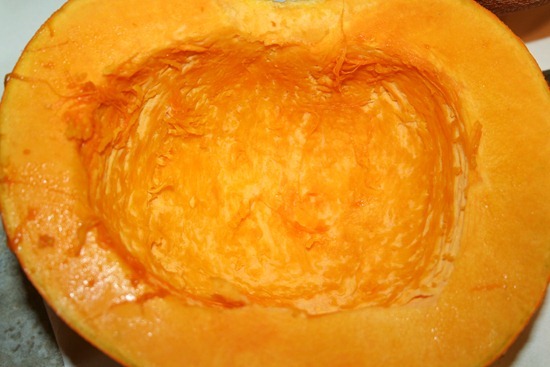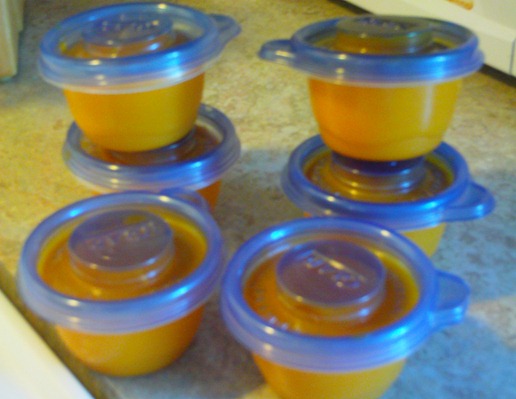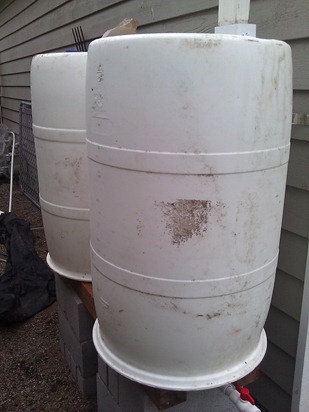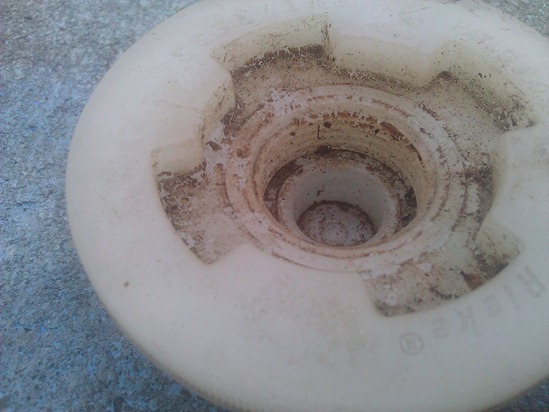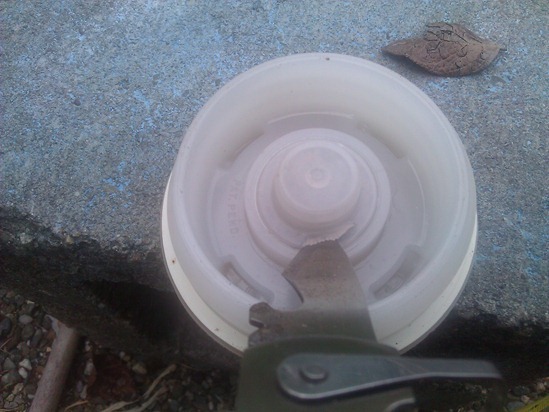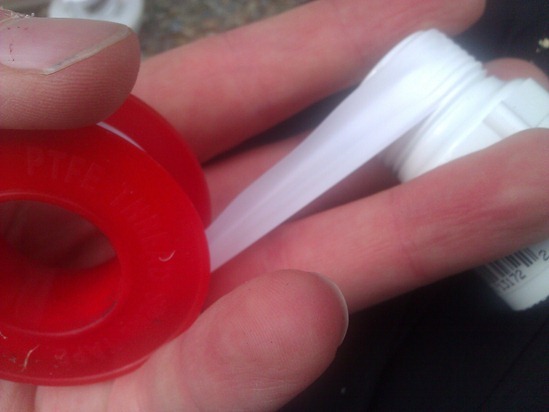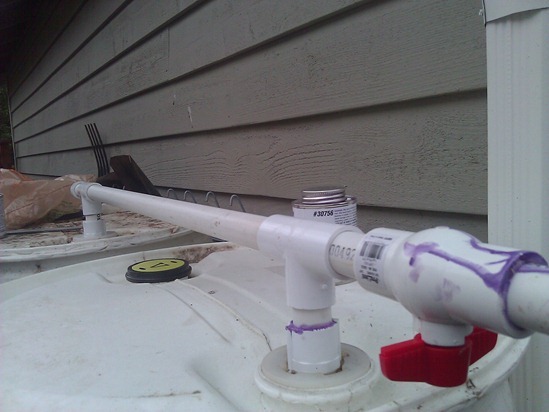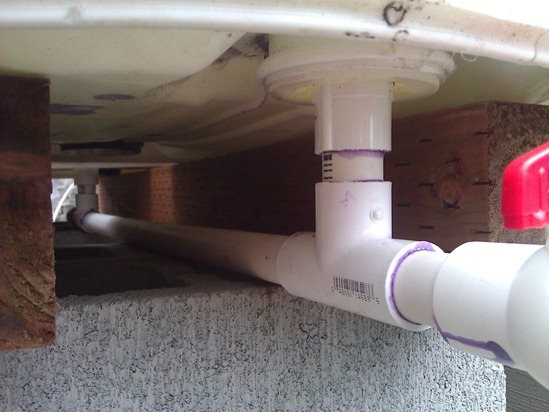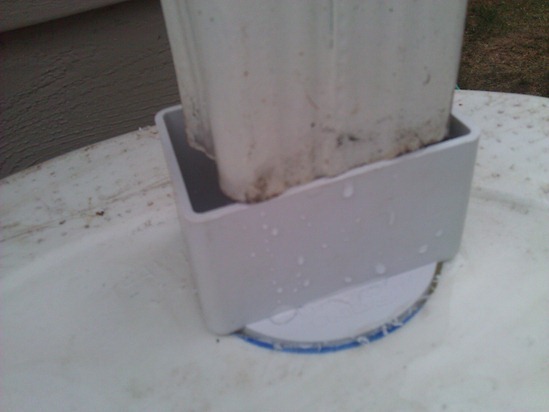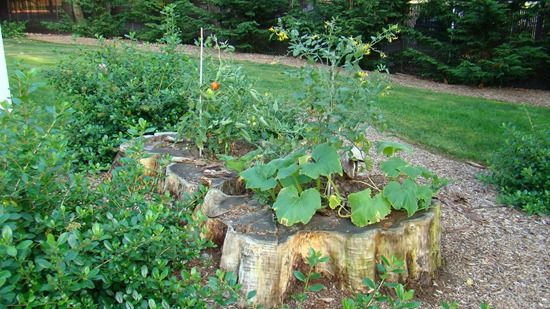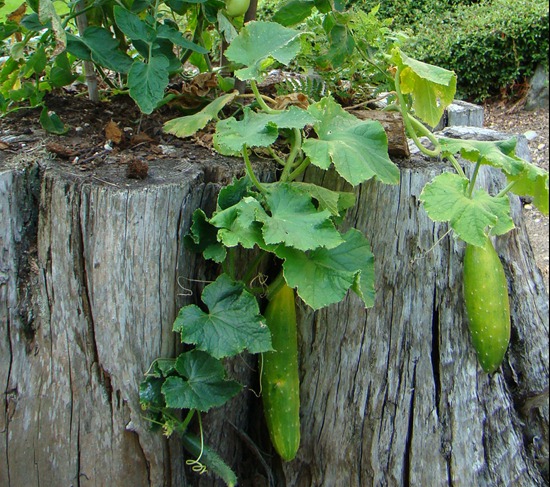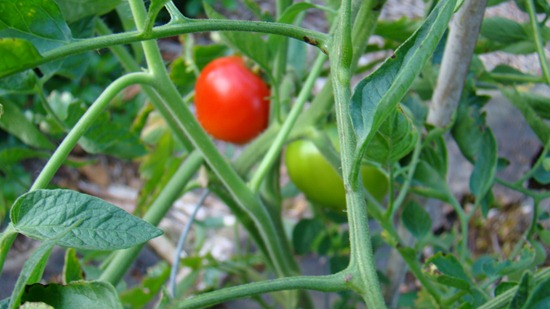Recent Articles
How to make a home garden greenhouse
11.5 years ago greenhouse, guest post, winter garden 3 Comments
As the world is speeding up its pace of development every second, we are losing many important things on earth. Saving environment where we live is the need of the hour. We are losing so much greenery every hour around the world that the time is not far when greenery will be hard to find. Though governments are making efforts to save the environment, it’s not enough- our efforts value the most. Greenery is very important for humans life cycle as it takes in carbon dioxide and give us oxygen to breathe in.
Greenhouses are generally built to somewhat gain control over the environment suitable for plants. Greenhouses are generally build to create an atmosphere for growing off season vegetables all-round the year. One can easily make greenhouse garden at home with some easy to make a home garden greenhouse. Below are a few popular varieties you can create yourself or purchase a kit to save a considerable amount of money.
Frames
The greenhouse frames are of three types- the “Quonset” which is simple tunnel shaped, ridged beam with taller gothic shape having arched sidewalls and third one with vertical side walls having able roof. Choice of greenhouse generally depends on cost and gardening goals. The ridged beam and Quonset are mainly for rookie gardeners who have less gardening experience.
Quonset
This basic inexpensive Quonset greenhouse structure is made from 1/2 inch PVC plastic pipe. Quonset is suitable for rookie gardeners who wish to increase the growing season and are interested in cultivating early spring seedlings. Quonset base is egg shaped, two-by-four frame directly placed on the ground. The roof has several half cut plastic lengths attached to each other with the insides of longitudinal base at distance of three to five foot. It comprises of a UV-resistant heavy plastic film, which is used for covering the roof. The walls at the ends have door frames with adjustable sliding doors on both ends providing access and ventilation to greenhouse.
Gothic
Gothic greenhouses are tall as compared to Quonset shape. They have central ridge and have arched sides. Gothic greenhouses provide better headroom and storage along with the sidewalls. This type of greenhouse can be raised on ground or concrete slab if user is planning to use growing tables or raised beds. In Gothic greenhouse wooden arches are used on inside edges of the base frame on longitudinal sides. Flexible polycarbonate or see-through panels made of fiberglass are fixed to wooden frames with screws. Adjustable sliding doors are used to cover ends for ventilation and access. Gothic greenhouses can be of great use to serious gardeners who want to increase the cultivation seasons up to four times.
Rigid Frame
These greenhouses are built by professional contractors. Rigid Frame greenhouses have permanent structure without supporting pillars in center. These types of greenhouses need building permit plan approvals. Rigid Frame greenhouses are built on concrete foundations with vertical sidewalls. They have full facility of controlling humidity, lighting heating and ventilation. Its exteriors are built with fiberglass sheeting, polycarbonate panels and glass. These greenhouses can be used for cultivation all-round the year and used by professional farmers and horticultural nurseries.
These are some of the garden greenhouses which one can make according to his/her requirements and budget.
About The Author: Alia is a journalist and blogger. She is a contributor to several sites such as Marnie Bennett.
How to make pumpkin puree
11.6 years ago cheap, pumpkin, puree 4 Comments
It is that time of year again to stock up on some pumpkin puree from some fresh pumpkins. Not sure if it is the 3rd daughter or just getting older but this year I have come up with an ever faster way to convert pumpkins into puree. Not only does this give you a better tasting pie, but given a organic pumpkin cost $6 a can you also save quite a bit of money with just a little additional work.
Step 1: Clean the pumpkin. Use a little water and scouring pad to remove loose dirt
Step 2: Remove stem and cut pumpkin in half. This will take a little muscle to get through but using a serrated blade should make quick work of this little pumpkin.
Step 3: Scoop out seeds and innards. Using an ice cream scoop. scrape out the seeds and the stringy innards, you don’t have to get this completely clean as you can see below. I also decided to save a few seeds with hopes to grow my own sugar pumpkins next year using the seed saving techniques I have wrote about last year.
Step 4: Cook the pumpkin. Places halved pumpkins on a cookie sheet. Place in a preheated oven at 350F and cook the pumpkin for 1.5-2 hours. The pumpkin is done cooking when you can slice through the pumpkin flesh with an edge of a fork with almost no effort.
Step 5: Scape out cooked pumpkin. When the pumpkins are cool enough to handle simply take a large spoon and scrape out the cooked pumpkin and scoop into a large bowl being careful to not scrape too hard and accidentally get some pumpkin skin in the mix.
Step 6: Blend. Use a large metal spoon to scape the pumpkin away from the skin and place into a blender and blend until smooth. Typically this can be as much as 1/3 water to 2/3 cooked pumpkin to get a good vortex going like above.
That is it. With my 5 pound pumpkin I purchased for $5 I got 6 cups of pumpkin puree, which is enough to make 3 pumpkin pie or 6 loafs of pumpkin bread and if my math is right about $30 compared to buying the canned variety. After making a pie and a loaf of pumpkin bread this left me with 3 cups of pumpkin goo, which I put in 6 half-cup containers which I froze to make some more pie for Thanksgiving.
Add some color to your vegetable garden
11.6 years ago Uncategorized Leave a comment
Vegetable gardening is a great activity to engage in, it is fun, nurturing and provides tangible results. Year after year many people take great satisfaction in producing their own fruit and vegetables at home. However sometime gardeners look to “spice” things up and create some variety in their routine. Planting less well known and visually interesting strains of vegetables is a great way to do this.
Thanks to the internet a real niche market has been carved out for adventurous vegetable gardeners. You can purchase luminous carrot or striped tomato seeds online through specialist vendors. This opens up a whole new interesting world at the click of a button.
Some vegetable gardens are now verging on art. Gardeners are pushing for the most aesthetically appealing vegetable patch possible. Some even carefully place their seeds so that the vegetables grow in set patterns. Imagine it like landscape design with vegetables!
Below are some of the cool and unique vegetables we’ve found for cheap just from browsing around amazon. All of these seeds can be picked up for under $5 and some are even under $1, so it’s by no means an expensive purchase.
Colorful Carrots
 Solar Yellow |
 Lunar White Lunar White |
 Purple Dragon |
 Blood red |
Beautiful Brocolli
 Romanesco |
 Purple Purple |
Crazy cauliflower
 Orange Cheddar |
 Purple |
Tuneful Tomatoes
 Black sea |
 Zebra |
 Rainbow |
So you can see that there is a whole world of fun veg out there just waiting to be grown. Why not get online and start searching around to see what you can find. Alternatively you can go to your local garden center and see if they have any interesting seeds in stock.
This post was written by Peter McAllister from SGM. They sell a range of garden equipment such as scarifiers and second hand lawn mowers.
How to setup cheap rain barrels
11.6 years ago cheap, rain barrels, water 1 Comment
Living in the rainy Pacific Northwest I have considered setting up some rain barrels to save a little on my water bill, but to also provide a water outlet to an area in my garden where one is not available.
The biggest inhibiting factor of doing this sooner was cost, typically rain barrel kits cost at least $100 and though as you can see below might be a little more aesthetically pleasing this is quite a bit of money to spend for something I am going to hide behind my garage anyway I went for a much cheaper option with a little do-it-yourself.
Materials Needed
- 55 gallon food grade plastic barrels X 2
- 3/4 in. Slip x MHT PVC Fitting
- 3/4 in. Male Terminal Adapter
- 3/4“ PVC Tee connector X 2
- 3/4” PVC elbow connector
- 3/4” PVC end cap
- Hose Barb Adapter (5/8” Barb X 3/4” MIP)
- 5/8” plastic tubing
- 3/4” PVC ball valve (get a second one if you want to be able to add more barrels without draining out all the water)
- 1.5” length of 3/4” PVC pipe X 2
- 2” length of 3/4” PVC pipe X 2
- Vinyl plumbers tape
- PVC primer/cement
- Cinder Blocks (at least 2 for each water barrel…I went with 6 for each barrel for additional water pressure)
- 4”X4” Lumber (8 foot)
Construction
Knowing Pascal’s principle I wanted to take advantage of all the height I could safely get. I chose to elevate my rain barrels by taking cinder blocks 2 wide and 3 high. I then place two 4”X4” lumber cut at 4 foot lengths to provide a few additional inches bust also provide some room for my connections which I will explain below.
Now I have a firm foundation not it is time to get these barrels hooked together so I can get maximum water pressure and access to the water in all of the barrels.
The caps on the barrels (pretty common) I picked up had a nice feature of including some nice threads on the inside of them. This provides me a nice 1 inch thread I can get a nice tight seal. The only problem these are sealed.
Not having a drill bit just under one inch in diameter I used a pocket knife to carefully cut the inner cap off being careful to not harm the threads.
Next I applied some silicon tape to the 3/4 in. Male Terminal Adapter and screw these into the lids and then attached the lid back into the water barrel. Repeat this step for each of the barrels.
Next cut two 1.5 inch lengths of 3/4 PVC pipe and place between the 3/4 in. Male Terminal Adapter and the 3/4“ PVC T connector.
Now cut two 2 inch lengths of 3/4” PVC pipe and place at either end of the T connector on both barrels.
Next attach your 3/4” PVC ball valve to both ends (or 3/4” PVC end cap if you are not planning on adding any more barrels to your system.)
Finally measure the length between the remaining span of your water barrels and cut that to length.
Once you have everything fit as you like it use PVC primer/cement to make everything permanent except the connections between the T-connector and the threaded connector attached to the barrel.
Now (with PVC assembly removed) flip the barrels over to their final resting place and prime/cement last connections giving barrels a slight twist to make sure you have a good seal in the PVC cement.
Next cut a hole in the top of one barrel and be sure to place a screen between the rainspout and the opening of the barrel to keep mosquitos from making a home in your barrel.
In each of the other barrels you will need to add a hole for venting. I will I completely forgot this step and woke up confused why only one barrel contained 90% of the water after our first rain. Once I drilled a 1/4” hole into my second barrel I got a good blast of air in my face and the barrels equalized.
Lastly you need to add an overflow preventer, for this I drilled a one inch hole and then added a Hose Barb Adapter (5/8” Barb X 3/4” MIP) and a small length of 5/8” plastic tubing returning to the drain (with screen attached to keep bugs from coming up the tube.
To make sure you do not have any leaks (and being so excited to see your hard work in action) you can throw your onto your roof and let the water run for a few minutes to make sure you do not have any obvious issues such as leaks at any of your connections.
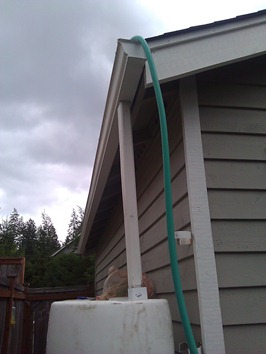 |
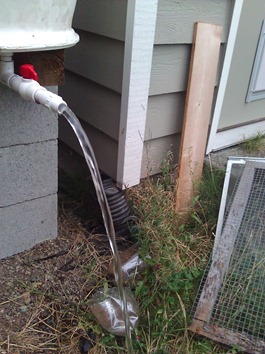 |
I also added a 3/4 in. Slip x MHT PVC Fitting which allows me to directly connect a garden hose or automated drip irrigation system (see upcoming post..)
So now I have the ability to capture up to 110 gallons of water, since I am only capturing one half of the water from the roof of my garage which equates to 196 square feet. Given for every inch that falls on a square square foot of surface area equals 0.6234 gallons so this means with just a single inch of rain these barrels will be over flowing providing weeks of water for a small vegetable garden.
Zucchini Muffin Recipe
11.7 years ago recipe, zucchini Leave a comment
This is the time of year when you have more zucchini in your garden than you can deal with. You neighbors are closing their blinds when they see you coming up the street, here is a delicious option to make use of some of the fruits of your labor.
You can use this same recipe to make a large loaf of bread, but I like the muffin option since it is easier for my kids to grab a snack without having to pull out a knife to slice it up.
Zucchini Muffin/Bread Recipe
- 2 cups all-purpose flour
- 1/2 cup brown sugar (packed)
- 1/4 cup white sugar
- 1 teaspoon cinnamon
- 1/2 teaspoon ground ginger
- 1 teaspoon baking soda
- 1/2 teaspoon baking powder
- 1 teaspoon salt
- 1 cup old fashioned oats
- 3 large eggs
- 2 teaspoons vanilla
- 2 cups finely grated zucchini (2 medium or 1 large zucchini)
- 1/2 cup chocolate chips (optional)
Ingredients
Directions
- Preheat oven to 350F.
- Stir flour, sugars, spices, baking powder/soda, salt, and oats into large bowl.
- Combine eggs and vanilla to a small bowl, beat and add to larger bowl
- Squeeze out liquid from grated and combine to large bowl until well combined. Add chocolate chips and stir until well incorporated
- Add batter to 9”X5” loaf pan or into 24 muffins.
- Bake for 60 minutes (bread loaf) or 45 minutes (muffins) and allow to cool for 10 minutes before attempting to slice/consume.
Growing vegetables gardens in stumps
11.7 years ago guerilla gardening, outdoor seed starting, vegetables 6 Comments
Many people may have heard of guerilla gardening where eager gardeners will make use of an abandoned lot and start a little vegetable garden on the down low. Here is another take on a similar idea but a little more out in the open.
My brother-in-law lives in a condominium that unfortunately does not provide much space for an outdoor garden with the exception of several potted plants on a patio. Looking for a what to expand his garden and get some sun loving plants in the ground he found a great location in some rotting stumps in a common area.
First he dug out some of the rotten wood with enough space of the desired plant to grow. Next he filled the area with some good quality soil, plant, and water and let nature do the rest of the work.
So far the results look great with some cucumbers ready for picking…
And some nice ripe tomatoes on the vine.
Now one of the disadvantages of growing outside of your own land is you may end up with some fruit missing from people passing by but definitely a great way to bring a little more life to your neighborhood.








